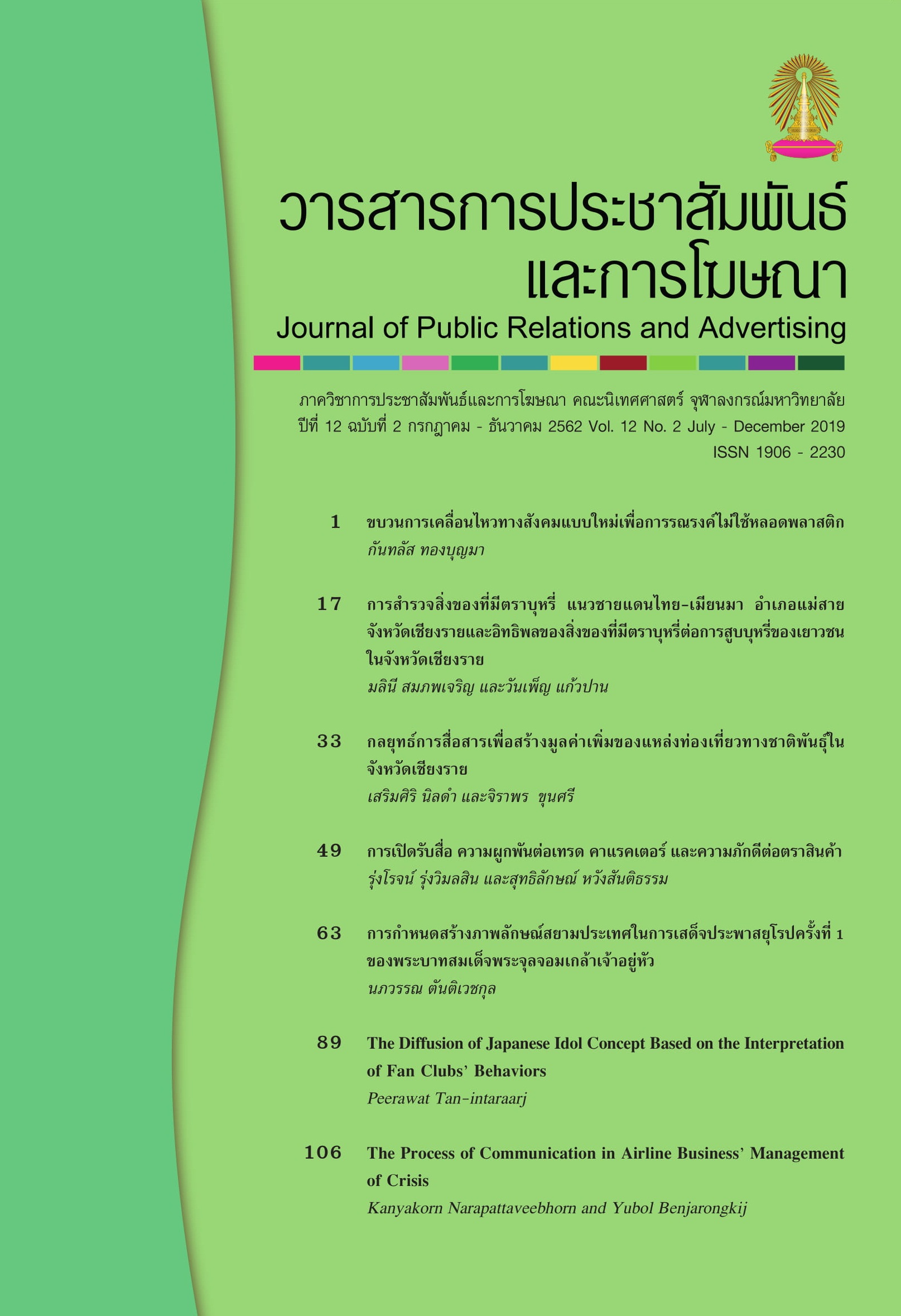การสำรวจสิ่งของที่มีตราบุหรี่ แนวชายแดนไทย-เมียนมา อำเภอแม่สาย จังหวัดเชียงราย และอิทธิพลของสิ่งของที่มีตราบุหรี่ต่อการสูบบุหรี่ของเยาวชนในจังหวัดเชียงราย
Main Article Content
บทคัดย่อ
งานวิจัยเรื่องการสำรวจสิ่งของที่มีตราบุหรี่ แนวชายแดนไทย-เมียนมา อำเภอแม่สาย จังหวัดเชียงรายและอิทธิพลของสิ่งของที่มีตราบุหรี่ต่อการสูบบุหรี่ของเยาวชนในจังหวัดเชียงรายเป็นการวิจัยแบบผสานวิธี โดยมีวัตถุประสงค์การวิจัยเพื่อสำรวจสิ่งของที่มีตราบุหรี่ที่มีการวางจำหน่ายตลาดชายแดนทั้งฝั่งไทยและเมียนมา บริเวณอำเภอแม่สาย จังหวัดเชียงราย และสำรวจแหล่งในการซื้อสินค้าที่มีตราบุหรี่ของนักเรียนในจังหวัดเชียงราย ตลอดจนศึกษาอิทธิพลของสินค้าของที่มีตราบุหรี่ต่อการสูบบุหรี่ของนักเรียน นักศึกษาในจังหวัดเชียงราย รวบรวมข้อมูลโดยใช้การสังเกตพร้อมกับแบบตรวจสอบรายการสิ่งของที่มีตราบุหรี่บริเวณตลาดชายแดนไทย-เมียนมา รวมทั้งการสำรวจด้วยแบบสอบถามนักเรียนนักศึกษาในจังหวัดเชียงรายจำนวน 252 ราย และสัมภาษณ์เชิงลึก 10 รายถึงแหล่งในการซื้อสินค้าที่มีตราบุหรี่และอิทธิพลของสิ่งของที่มีตราบุหรี่ต่อการสูบบุหรี่
ผลการศึกษาพบว่า สิ่งของที่มีตราบุหรี่ไม่มีวางจำหน่ายที่ตลาดชายแดนฝั่งไทย แต่พบในตลาดฝั่งชายแดนเมียนมา แหล่งในการซื้อสิ่งของที่มีตราบุหรี่ในจังหวัดเชียงรายพบว่าจะมีวางขายตามร้านขายของชำทั้งขนาดเล็กขนาดใหญ่ที่มีคนเข้าไปจับจ่ายซื้อของจำนวนมากเป็นประจำ และตลาดนัดหน้าโรงเรียน ส่วนอิทธิพลของสิ่งของที่มีตราบุหรี่จากการได้เห็น หรือได้เคยสะสม ไม่มีผลต่อการสูบบุหรี่ สิ่งที่ควรเฝ้าระวังของการเผยแพร่สิ่งของที่มีตราบุหรี่คือการลักลอบเข้ามาของสินค้าดังกล่าวจากฝั่งเมียนมา และมาวางจำหน่ายในฝั่งไทยที่ไกลออกจากแนวชายแดน และการเฝ้าระวังการซื้อขายสิ่งของที่มีตราบุหรี่บนตลาดออนไลน์ที่สามารถซื้อขายได้ตลอดเวลาและกฎหมายยังบังคับใช้ไปไม่ถึง
Article Details
เอกสารอ้างอิง
นิทัศน์ ศิริโชติรัตน์, พิมพ์พรรณ ศิลปสุวรรณ,ชูเกียรติ วิวัฒน์วงษ์เกษม, ดุสิต สุจิรารัตน์, ปรารถนา สถิต, วิภาวี, นฤมล เอื้อมณีกุล, นรินทร์ ปานดี และมลินี สมภพเจริญ. (2560). ความคิดเห็นต่อภาพคำเตือนบนซองบุหรี่แบบเรียบและผลต่อความเกรงกลัวอันตรายของบุหรี่ในกลุ่มเยาวชนที่ไม่สูบบุหรี่. วารสารศาสตร์, 10(3), 269-302.
ประกิต วาทีสาธกกิจ. (2559). Next step of Action on Smoking and Health Foundation Thailand. วันที่เข้าถึงข้อมูล 4 พฤษภาคม 2561 แหล่งที่มา http://www.ashthailand.or.th/content_attachment/attach/eaf29e1.pdf.
ปรีชา อุปโยคิน, พลวัฒ ประพัฒน์ทอง และภัทรา ชลดำรงค์กุล. (2560). ความหลากหลายกลุ่มชาติพันธุ์ กับการพัฒนาเศรษฐกิจชายแดนในอำเภอแม่สาย จังหวัดเชียงราย. วารสารสังคมศาสตร์. คณะรัฐศาสตร์.จุฬาลงกรณ์มหาวิทยาลัย. 47(1): 81-105.
มลินี สมภพเจริญ, วันเพ็ญ แก้วปาน และปาหนัน พิชยภิญโญ. (2556). ช่องทางการจัดจำหน่ายสิ่งของที่มีตราบุหรี่ (Cigarette promotional items : CPI). สิ่งที่ผู้ขายก็ไม่รู้ ผู้ซื้อก็ไม่ทราบว่า...ผิดกฎหมาย.วารสารนิเทศศาสตร์, 31(2), 27-36.
โรงงานยาสูบ กระทรวงการคลัง. (2561). Product of Thailand Tobacco Monopoly. วันที่เข้าถึงข้อมูล 5 พฤษภาคม 2561 แหล่งที่มา http://www.thaitobacco.or.th/
วิภวานี เผือกบัวขาว, ประสารโชค ธุวะนุติ และชนัต เผ่าพันธุ์ดี. (2560). การกำหนดนโยบายส่งเสริมการค้าชายแดนไทย - เมียนมา จังหวัดประจวบคีรีขันธ์. Veridian E-Journal ฉบับภาษาไทย สาขามนุษยศาสตร์ สังคมศาสตร์และศิลปะ, Silpakorn University, 10(3), 68-85.
ศูนย์วิจัยและจัดการความรู้เพื่อการควบคุมยาสูบ(ศจย.) มหาวิทยาลัยมหิดล. (2556). สรุปสถานการณ์ตัวชี้วัดตามยุทธศาสตร์การควบคุมการบริโภคยาสูบของประเทศไทย ปี 2556. วันที่เข้าถึงข้อมูล 22 มิถุนายน 2561. แหล่งที่มา http://www.trc.or.th
ศูนย์วิจัยและจัดการความรู้เพื่อการควบคุมยาสูบ(ศจย.) มหาวิทยาลัยมหิดล. (2558). รายงานการประชุมบุหรี่และสุขภาพแห่งชาติ ครั้งที่ 14 “หนุนกฎหมายบุหรี่ใหม่เพื่อคุณภาพชีวิตคนไทย”.
ศูนย์วิจัยและจัดการความรู้เพื่อการควบคุมยาสูบ(ศจย.) มหาวิทยาลัยมหิดล. (2559). รายงานผลการประเมินการปฏิบัติตามกรอบอนุสัญญาว่าด้วยการควบคุมยาสูบของประเทศไทย พ.ศ. 2559. กรุงเทพมหานคร : เจริญดีมั่นคงการพิมพ์.
สำนักควบคุมการบริโภคยาสูบ กรมควบคุมโรค กระทรวงสาธารณสุข. (2560). พระราชบัญญัติควบคุมผลิตภัณฑ์ยาสูบ พ.ศ. 2560. ปทุมธานี : โรงพิมพ์มหาวิทยาลัยธรรมศาสตร์.
Brock, B., Schillo A. B., Moilanen, M. (2015). Tobacco industry marketing : an analysis of direct mail coupons and giveaways. Tob Control, 24, 505-508.
Clow, E. K., and Baack, D. (2007). Integrated advertising, promotion and marketing communication. 3rded. Pearson Education Limited, Upper Saddle River. New Jersey.
Fisher, M. P., Schwartz, M. P., Richards, J. W. (1991). Brand Logo Recognition by Children Aged 3 to 6 Years Mickey Mouse and Old Joe the Camel. JAMA, 266(22), 3145-3148.
Ganz, O., Teplitskaya, L., Cantrell J., Hair, C. E., and Vallone, D. (2016). Direct-to-Consumer marketing of cigar products in the United States. Nicotine & Tobacco Research, 18(5), 864-868.
Grant-Braham, B., and Britton, J. (2012). Motor racing, tobacco company sponsorship, barcodes and alibi marketing. Tab Control, 21(6), 529-535.
KItchen, P. J. (2010). Integrated brand marketing and measuring returns. Hampshire: Palgrave Macmillan, 68.
Lempert, L. K., Glantz, S. A. (2018). Tobacco industry promotional strategies targeting American Indians/Alaska Natives and exploiting tribal sovereignty. Nicotine & Tobacco Research, 1-9.
Owotomo, O., Maslowsky,J., Pasch,K.E. (2017). Historical declines and disparities in cigarette coupon saving among adolescents in the United States, 1997-2013. Preventive Medicine, 100, 61-66.
Pechmann, C., and Ratneshwar, S. (1994).The effect of antismoking and cigarette advertising on young adolescents’ perceptions of peers who smoke. Journal of Consumer Research, 21, 236-251.
Sargent, J. D., Dalton M. A., Beach, M., et al. (1997). Cigarette promotional items in public school. Arch Pediatr Adolesc Med, 151(12), 1189-1196.
Schroeder, J. E., and Detlev Zwick. (2004). Mirrors of masculinity : representation and identity in advertising images. Consumption Markets & Culture, 7(1), 21-52.


